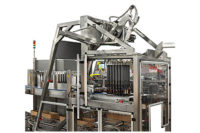![]()
Case Study:
Fuze Beverage, Holiday Stationstores form healthy partnership
by Laurie Russo
In today's consolidation-heavy environment, it's not often that
a relatively small, independent marketer gets the chance to waltz into a major
c-store chain — and waltz out with equally major cooler space. Yet that's exactly
what New Jersey's Fuze Beverage managed to achieve with Holiday Stationstores.
The Bloomington, Minn.-based retail chain, which
boasts close to 400 stores (301 corporate, 91 franchise) in 12 states in
the Midwest, Northwest, and now Alaska, liked what it saw of the healthy
refreshment line, and took a chance. Holiday's Director of Direct Store
Distribution and Franchise Marketing, Larry Mitchell, says, “It's a
unique product — it's not a me-too. It's what we call
‘healthy-for-you.’ Customers are looking for healthy
alternatives, and in convenience stores, there are usually not too many.
This product created one.”
Fuze's colorful bottles contain 11 “Healthy
Infuzions” of juice blends and teas, all loaded with vitamins,
minerals and polyphenols, and separated by function into lines such as
Refresh, Energize, Essentials and Slenderize. Two new varieties, Strawberry
Melon (Slenderize) and Strawberry Guava (Refresh), are slated for the
summer.
Mitchell's instincts told him to give Fuze four
facings in 2003. Fuze Vice President of Marketing Jeff Powers recalls,
“After the first year with no promotions, we found ourselves in one
of the top positions of volume-per-facing for all of the new items, yet due
to the Pepsi and Coke contracts, we were
restricted by the percentage of the vault they controlled.”
With that in mind, Fuze considered itself fortunate
that Mitchell had given over the four facings. But the best was yet to
come.
“After the brand's success in 2003,
[Holiday’s] new planogram was completed for 2004, and we had more
than doubled our space to a full shelf in most, and a shelf and a half in
the larger stores,” says Powers. Fuze, “the little beverage
that could”, was now set to occupy nine facings in Holiday stores.
“We were doing well in Holiday stores. Fuze had
already proved itself on its own merit, with no price promotions, so we
decided to put a little oomph behind it by doubling the shelf space and
implementing promotions," continues Powers. “Larry gave us prime
position and agreed to promote our brand in key months to drive more
sampling of the product.”
Sampling is always a bit easier when the product
itself draws customer attention. “The packaging is outstanding, and
it really stands out in the coolers. That alone
sells product for us,” enthuses Mitchell. “So we've given Fuze
very good positioning within the cold vault, and we're going to allow them
to develop a special channel strip.”
Fuze is busy developing a die-cut shelf strip, which
will give it the opportunity to use Holiday shelves to educate its
consumers on the health benefits of drinking Fuze.
Holiday does not allow vendor point-of-sale materials
without authorization. “Typically we have what we call a sales
builder that we put in every cooler door, highlighting several brands. But
now we're putting a Fuze-specific sheet highlighting that one brand for
that month on a promotion, and that is unique for us,” Mitchell says.
Two 2004 Fuze promotions, implemented and executed by
Mitchell, his assistant Cheryl Ackerman, and Fuze’s Todd Gibson, have
stood out in both sales and POS innovation for the chain. One features a
two-for-$2 price promotion (Fuze normally sells for around $1.29); the
other, a new entry called “Fuel Up & Slim Down,” is a
cross-promotion that takes advantage of the low-carb diet trend. Holiday
has created a new low-carb sandwich, and the tie-in gives customers who buy
it a 50-cent discount on any Fuze product.
The promotions have taken off. “The last four
weeks [April-May] combined we have sold 50 percent of our 2003 product
sales in the Holiday chain,” says Powers. “And one week in
mid-May was our largest so far in the chain, selling more than 1,500
cases.”
The keys to the success of the Fuze/Holiday program?
“Keeping the product in stock and monitoring the sales," says
Mitchell. “We went through some growing pains like anything else, but
we stuck with it and it worked.”
Instinct, he says, is one thing, but follow-up is
crucial. “We ran the numbers. We scan in all our stores, so I watched
the numbers, made sure we were doing what we needed to do. We got our days
of supply requirements and our profit per SKU and all that. We continued to
follow up to make sure those goals were met, and that's how we went from
four to nine facings.”
Mitchell stresses that follow-up is essential to
eliminating out-of-stocks because they kill sales. “When we keep up
on service with Fuze and its distributors, we minimize
out-of-stocks.”
So marketers, beware — sales are not the be-all and end-all.
The popularity and sales of the product are only half the equation in a successful
program. “The product can fly off the shelves,” warns Mitchell, “but if you
leave the chain with out-of-stocks, you're not going to make it.”


